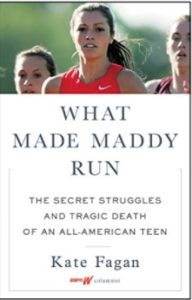 Kate Fagan’s What Made Maddy Run is a heartbreaking, yet essential read.
Kate Fagan’s What Made Maddy Run is a heartbreaking, yet essential read.
“In interviews with Madison (Maddy) Holleran’s family and friends, and exhaustive reading of her texts, instant messages, and emails, Fagan reconstructs Maddy’s descent into mental illness that ultimately led to the elite athlete’s suicide at the University of Pennsylvania.
What emerges is a haunting recounting of a mental illness that probably had roots long before Maddy’s days in track at the University of Pennsylvania, but manifested itself there with the transition from high school elite athlete to a competitive college athletics program.”
I remember dreaming of college and what I thought it would be like. I remember the transition being challenging in some ways- this only child had to learn to effectively share with other people and give up privacy- but it seems to be harder now than it was then. And it can be even more difficult for athletes or other elites, who were standouts in their high school world but just one of many in the college network. Additionally, this generation has always been digital. Their whole lives are instagrammed or facebooked or snap-chatted in ways that show only the best. Filtered to show them in the best light. They text with their parents constantly, and are receiving immediate feedback on everything in the form of likes. Somewhere in the mix of it all, the transition to college is that much harder.
When a student also suffers from mental illness, the challenges of transition are only exacerbated. What makes What Made Maddy Run so heartbreaking is that no one was in denial that Maddy was in trouble. Her parents were deeply concerned. Parents of her friends noticed things. Maddy was seeing and finding a new therapist. She had a plan in place to get her through the semester at Penn when she could then look at other options for schools. She seemed to be hanging on….until.
Fagan recounts Maddy’s story with sensitivity and unexpected insight. She shares text conversations between herself and others with insight into depression. She’s compassionate and respectful of both Maddy and her family. Maddy’s story is heartbreaking because it is so relatable. And sadly, not so uncommon. Many college and university coaching staffs and health facilities are not equipped to effectively deal with mental illness. By telling Maddy’s story, Fagan helps bring awareness to this issue.
And Fagan reminds us that what we see on the surface isn’t always what’s going on with someone. A good reminder for us to be a little kinder to each other.
Although this one doesn’t have a happy ending, I consider it essential reading.